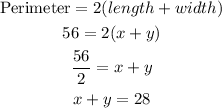Let the length of the rectangle be "x" and the width be "y".
We know the formula for the area of a rectangle:

We know the formula for the perimeter of a rectangle:

Let's solve for "x" in the perimeter equation to get:

Now, we will substiute this into the Area equation. Shown below:

To find the maximum area, we need to differentiate "A" equation and set it equal to 0 to find the value of "y" for which "A" is maximum. The steps are shown below:

The corresponding "x" value is:

Thus, the rectangle with the maximum area is the one with dimensions:
